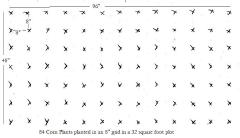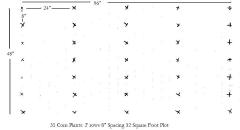|
Some Frugal Garden Tips
Here's some of my frugal garden tips that you may not have seen elsewhere on the net. Of course, you can garden without being a cheapskate, but what’s the fun in that? I mean, who wants to pay full price for those spindly plants in their biodegradable pots that you find at the garden centers every spring. Why not start your own plants from seed, saved from last years garden, in reusable pots? (More on that later.). One of the fun things about gardening is the amount of time that you can spend in December and January just planning your garden. Especially when the seed catalogs start arriving with all of their mouth-watering pictures. Even though you’re not going to be spending your hard earned cash with them, those catalogs are full of valuable information that you can use for free. For example, to feed a family of four all year round, you will need to plan a vegetable garden that is about 100 sq meters (1076 sq ft) of growing area, not including paths. Don’t despair if you don’t have that much room, because there are ways to compensate. One that comes to mind is a book titled Square Foot Gardening by Mel Bartholomew. Of course, as part of the planning process, you will have to decide what you’re going to grow, as that can have a definite impact on the amount of room you’re going to need. For instance, if you’re going to grow radishes, and not corn, you would need a lot less space. The
Purdue University Extension Service
says to plant corn in rows 2-3 feet apart with the seeds 8-10 inches apart and to plant 4 or more short rows to aid in pollination.
If you follow those guidelines you can get 7 plants in each row and 35 plants in a patch that is 4 foot by 8 foot. 
If you plant in the intensive method, you will have a plant every 8-10 inches in each direction, so that you can put up to 84 plants in that same 4x8 plot. According to the University of Illinois Extension Service , you would only need to plant your radishes 2-3 inches apart, so you could get 84 of them in a 1x2 foot plot. 
Bottom line is that you need to do some planning up front. Those reusable pots mention above are just your small yogurt containers. What makes them neat for pots is their shape: wider at the top than the bottom. So punch a couple of holes in the lid, place it on the container and then turn it over and cut off the bottom with your kitchen shears. Now you can fill them with potting soil and put in your seeds, water and wait for planting time. You can use a boot tray as a waterer/holder for your starts. They are sturdy enough to be able to move around, even full of plants and they will keep any excess water from doing any damage. When you go to plant your seedlings, first dig a hole about the same size as your container. Now, remove the lid from the bottom and set the container in the hole. Gently push down on the soil inside the container while lifting the edge and your plant will be left nestled in the ground with minimal transplant shock. By only lifting the container about halfway up, and then leaving it in place, you have a nice cut-worm barrier around your new seedling. There are a lot of frugal gardening tips available on the net, so I’ll just mention a couple of mine. One area that a lot of folks don’t take in to consideration is the cost of watering their garden. Over-watering not only costs more in terms of dollars, but it also costs more in terms of harvest, as an over-watered plant will not do as well as one that is properly watered. The following is excerpted from How-Stuff-Works ********* So much depends on climate and the ability of different soil types to hold moisture that it's difficult to give specific directions for watering your garden. Generally, however, vegetable plants need about an inch of water a week. ************** It takes about 625 gallons of water to apply an inch to 1,000 square feet. After watering, the soil should be saturated approximately 3 to 4 inches. The trick is to know how much water you are applying to a given area. This calls for some (shudder) math.
First, we need to know the area, which is found by multiplying the length times the width. Using our corn plot from above, (4’x8’), we find that there are 32 square feet (sf) that needs watered. We find that this is 3.2% of the base area of 1000 sf. (32 divided by 1000). Knowing this, we can then find out what 3.2% of our base water total (.032 times 625) is and learn that we only need to apply 20 gallons of water to that plot, per week. How about that? Next we need to find out how long to water to get 20 gallons. Of course, that will depend on how we water: flood, sprinkler, drip, etc. The easiest way to calculate flow, since it is dependent on several factors, such as pressure, hose size, hose length and nozzle size, is to actually measure the output of the system. All it takes is a 5 gallon bucket and a stop watch, or at least a watch that counts seconds. Turn your system on first and then place the end of the hose or the sprinkler so that all of the water is directed into your bucket and then find out how long it takes to fill the bucket. If it takes exactly one minute, then you know that your flow is 5 gallons per minute (gpm). If it is 2 minutes, then the flow is 2.5 gpm and so on. Simply divide the total gallons (5) by the elapsed time in minutes. You may have to convert your time if for instance you have 2 minutes 49 seconds. There are 2 ways to do this: either multiply the minutes by 60 and add the seconds for a total and then divide by 60. (2x60=120 + 49=169/60=2.817 gpm) or just divide the seconds by 60 (49/60=.817) and add this to the minutes. Either way, you end up with your flow rate in gallons per minute. If you are using a rain bird type sprinkler, then you need to do a couple of other calculations. You need to know how much area the sprinkler is covering so that you will know how long to water. The formula is pi times the radius squared. You find the radius of the circle by measuring how far your sprinkle reaches (say 12’). Now multiply that number by itself (square it) and then multiply that number by 3.14.(12’x12’x3.14=452.16 sf) Now, take a short piece of hose, say 18-24”, slide it over the nozzle on your sprinkle, turn the water on and then direct the flow into your bucket. Once you know the flow rate for your sprinkler, you can calculate how long to leave it on to put an inch of water down. Knowing the flow rate and size of the area to be watered allows us to figure out how long to water. We can figure that it takes .625 gallons of water per square foot to put an inch of water in the soil, so just multiply the area by .625 and then divide that by the flow rate. (area x 0.625/gpm)(32 sf times .625 = 20 gallons, divided by 2.817 gpm = 7 minutes) Please keep in mind that the rule of one inch per week is just a rule of thumb. You need to take into account your soil type, the plants and the weather. Just knowing how to calculate your water usage allows you the flexibility to apply some common sense to your water bill.
For more tips on frugal gardening, you can order Frugal Garden Tips in an eBook. The Non-Consumers Gardening contains 62 tips in a pdf format. I don’t really know of any frugal way to pick your vegetables (yet). You bend over, grasp firmly with your fingers and pull gently. Now, if you’re picking black berries, you can be frugal and not eat ‘em as you pick ‘em. Remember, you’re going to want some come winter! If you would like to know when I update this site or add some more content, email me and I'll add you to my notification list.
One of my recommendations for maintaining a frugal household is that you subscribe to my free, weekly newsletter, which always contains a dozen or so of my various tips. (I do put in one ad at the bottom for you to ignore.) There are several volumes of Non- Consumer tips and How To articles available here. Return from Frugal Garden Tips to Frugal Gardening Return from Frugal Garden Tips to The Frugal Non-Consumer
|

